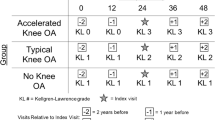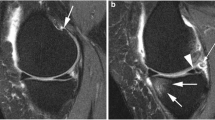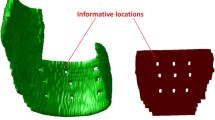Abstract
Objective
The aim of this work is to use quantitative magnetic resonance imaging (MRI) to identify patients at risk for symptomatic osteoarthritis (OA) progression. We hypothesized that classification of signal variation on T2 maps might predict symptomatic OA progression.
Methods
Patients were selected from the Osteoarthritis Initiative (OAI), a prospective cohort. Two groups were identified: a symptomatic OA progression group and a control group. At baseline, both groups were asymptomatic (Western Ontario and McMaster Universities Arthritis [WOMAC] pain score total <10) with no radiographic evidence of OA (Kellgren–Lawrence [KL] score ≤ 1). The OA progression group (n = 103) had a change in total WOMAC score greater than 10 by the 3-year follow-up. The control group (n = 79) remained asymptomatic, with a change in total WOMAC score less than 10 at the 3-year follow-up. A classifier was designed to predict OA progression in an independent population based on T2 map cartilage signal variation. The classifier was designed using a nearest neighbor classification based on a Gaussian Mixture Model log-likelihood fit of T2 map cartilage voxel intensities.
Results
The use of T2 map signal variation to predict symptomatic OA progression in asymptomatic individuals achieved a specificity of 89.3 %, a sensitivity of 77.2 %, and an overall accuracy rate of 84.2 %.
Conclusion
T2 map signal variation can predict symptomatic knee OA progression in asymptomatic individuals, serving as a possible early OA imaging biomarker.



Similar content being viewed by others
References
Brandt KD, Fife RS, Braunstein EM, Katz B. Radiographic grading of the severity of knee osteoarthritis: relation of the Kellgren and Lawrence grade to a grade based on joint space narrowing, and correlation with arthroscopic evidence of articular cartilage degeneration. Arthritis Rheum. 1991;34(11):1381–6.
David-Vaudey E, Ghosh S, Ries M, Majumdar S. T2 relaxation time measurements in osteoarthritis. Magn Reson Imaging. 2004;22(5):673–82.
Mosher TJ, Dardzinski BJ. Cartilage MRI T2 relaxation time mapping: overview and applications. Semin Musculoskelet Radiol. 2004;8(4):355–68.
Mosher TJ, Smith H, Dardzinski BJ, Schmithorst VJ, Smith MB. MR imaging and T2 mapping of femoral cartilage: in vivo determination of the magic angle effect. AJR Am J Roentgenol. 2001;177(3):665–9.
Wheaton AJ, Casey FL, Gougoutas AJ, et al. Correlation of T1rho with fixed charge density in cartilage. J Magn Reson Imaging. 2004;20(3):519–25.
Burstein D, Gray ML. Is MRI fulfilling its promise for molecular imaging of cartilage in arthritis? Osteoarthritis Cartilage. 2006;14(11):1087–90.
Xia Y, Moody JB, Alhadlaq H. Orientational dependence of T2 relaxation in articular cartilage: a microscopic MRI (microMRI) study. Magn Reson Med. 2002;48(3):460–9.
Harrison MM, Cooke TD, Fisher SB, Griffin MP. Patterns of knee arthrosis and patellar subluxation. Clin Orthop Relat Res. 1994;309:56–63.
Yulish BS, Lieberman JM, Newman AJ, Bryan PJ, Mulopulos GP, Modic MT. Juvenile rheumatoid arthritis: assessment with MR imaging. Radiology. 1987;165(1):149–52.
Urish KL, Keffalas MG, Durkin JR, Miller DJ, Chu CR, Mosher TJ.. T2 texture index of cartilage can predict early symptomatic OA progression: data from the osteoarthritis initiative. Osteoarthritis Cartilage. 2013;21(10):1550–7.
Blumenkrantz G, Stahl R, et al. The feasibility of characterizing the spatial distribution of cartilage T(2) using texture analysis. Osteoarthritis Cartilage. 2008;16(5):584–90.
Carballido-Gamio J, Link TM, Majumdar S. New techniques for cartilage magnetic resonance imaging relaxation time analysis: texture analysis of flattened cartilage and localized intra- and inter-subject comparisons. Magn Reson Med. 2008;59(6):1472–7.
Peterfy CG, Schneider E, Nevitt M. The osteoarthritis initiative: report on the design rationale for the magnetic resonance imaging protocol for the knee. Osteoarthritis Cartilage. 2008;16(12):1433–41.
Eckstein F, Hudelmaier M, Wirth W, et al. Double echo steady state magnetic resonance imaging of knee articular cartilage at 3 tesla: a pilot study for the Osteoarthritis Initiative. Ann Rheum Dis. 2006;65(4):433–41.
Urish KL, Williams AA, Durkin JR, Chu CR; the OAI Investigators Group. Registration of magnetic resonance image series for knee articular cartilage analysis: data from the osteoarthritis initiative. Cartilage. 2013;4(1):20–7.
Smith HE, Mosher TJ, et al. Spatial variation in cartilage T2 of the knee. J Magn Reson Imaging. 2001;14(1):50–5.
Duda RO, PE Hart, Stork DG. Pattern classification; 2nd Ed. 2000; Hoboken, NJ: Wiley-Interscience.
Schwarz G. Estimating the dimension of a model. Ann Statist. 1978; 6(2):461–464.
Joseph GB, Baum T, Carballido-Gamio J, et al. Texture analysis of cartilage T2 maps: individuals with risk factors for OA have higher and more heterogeneous knee cartilage MR T2 compared to normal controls—data from the Osteoarthritis Initiative. Arthritis Res Ther. 2011;13(5):R153.
Acknowledgments
The project was supported by the National Institutes of Health through grant number KL2 TR000146 and the Orthopaedic Research Education Foundation. Additional support was provided in part by the Woodward Family Endowment in Biomedical Engineering to the Penn State University. The OAI is a public–private partnership comprising five contracts (N01-AR-2-2258; N01-AR-2-2259; N01-AR-2-2260; N01-AR-2-2261; N01-AR-2-2262) funded by the National Institutes of Health, and conducted by the OAI Study Investigators. Private funding partners include Merck Research Laboratories; Novartis Pharmaceuticals Corporation, GlaxoSmithKline; and Pfizer, Inc. Private sector funding for the OAI is managed by the Foundation for the National Institutes of Health. This manuscript was prepared using an OAI public use data set and does not necessarily reflect the opinions or views of the OAI investigators, the NIH, or the private funding partners.
Author information
Authors and Affiliations
Corresponding author
Ethics declarations
Author contributions
All of the authors were involved in the experimental or software design, data analysis, and manuscript preparation.
Electronic supplementary material
Below is the link to the electronic supplementary material.
ESM 1
(DOC 81 kb)
Supplemental Table 1
WOMAC pain questionnaire. (XLSX 35 kb)
Rights and permissions
About this article
Cite this article
Zhong, H., Miller, D.J. & Urish, K.L. T2 map signal variation predicts symptomatic osteoarthritis progression: data from the Osteoarthritis Initiative. Skeletal Radiol 45, 909–913 (2016). https://doi.org/10.1007/s00256-016-2360-4
Received:
Revised:
Accepted:
Published:
Issue Date:
DOI: https://doi.org/10.1007/s00256-016-2360-4




